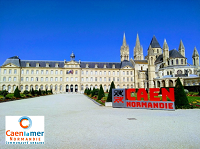Orateur
Description
The ultrarelativistic Pb+Pb collisions are the source of many interesting processes. One of them is creation of the virtual photons by two moving electromagnetic fields generated by charged spectators. Moreover, these photons can excite the Pb nuclei and excite them substantially. The Pb
Our study focuses on the photon induced Pb spectator and its various channels of dexcitation. We calculate cross sections for single and any number of n, p, $\alpha$, $\gamma$ in UPC (b > R1 + R2) for LHC energies. We analysis deexcitation of excited 208Pb for excitation energies E$_{exc}$ ∈ (0,500) MeV within Hauser-Feshbach formalism as encoded in the cascade program GEMINI++. At low excited energies we observe emission of neutrons and photons. At higher excitation energies E$_{exc}$
100 MeV we observe multiple emission of neutrons and photons, emission of single or in pairs of protons and alpha particles. Also fission channels open at larger excitation energies. The particles of a few MeV energy in the nucleus rest frame are emitted in a narrow cone in the laboratory (overall CM) frame after appropriate Lorentz boost ($\eta$> 10). We address a question whether such particles could be measured at the LHC. So far only neutrons are measured by the ZDCs. We calculated
energy spectra of the different particles. The energies of photons are rather small, below appropriate threshold. Protons and α particles could be measured by forward proton spectrometer. We estimated photoproduction cross section in Pb-Pb collision for single and multiple particles emission. Results are compared with existing ALICE data for neutron multiplicities at $\sqrt{s_{NN}}$=2. 76 and 5.02 TeV.

